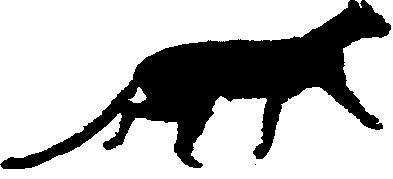Excerpts from Jim Conrad's
Naturalist Newsletter
from the August 30, 2018 Newsletter issued from Rancho Regenesis in the woods ±4kms west of Ek Balam Ruins; elevation ~40m (~130 ft), N~20.876°, W~88.170°; central Yucatán, MÉXICO
JAGUARUNDI

Last Saturday a little after noon I was biking beneath a very hot, bright Sun on the little paved road leading out of Ek Balam toward the ranch when a Jaguarundi, HERPAILURUS YAGOUAROUNDI crossed the pavement in front of me, about 40 meters (yards) distance. Though I'd never seen one before, I knew what it was immediately because it was shaped more or less like a domesticated cat, just larger and more powerfully built than any tomcat. Also it moved with a sense of presence that no house cat ever would display. Its body was too elongated and its tail too long and thick for it to have bee an Ocelot, Margay or immature Jaguar. It was close to Puma/ Couger/ Mountain Lion shape, but more elongated and smaller. In the Yucatan we only have those five wild cat species, so it just had to be a Jaguarundi. Based on a photo on the Internet, I prepared a silhouette showing exactly what I saw, and that's what is at the top of this page.
The Jaguarundi reaches up to 30 inches in total length (77cm), with legs that look a bit short for such a long cat's body. The ears are short and rounded, and the head small and roundish. The individual I saw was blackish but a bit silvery. When I told Juan at the rancho -- the most backcountry Maya fellow I've ever known -- about my sighting, he said that males are black and females sort of reddish yellow. However, this is Maya myth, for I read that there are two color phases, the gray, with the coat ranging from blackish to brownish-gray, and the red, with a hue from chestnut to foxy red, and they have nothing to do with gender. Earlier the two phases were considered to be different species, but now it's known that both phases can be born in the same litter, so the color reflects neither sex nor taxonomic position. I saw the gray color phase, though it was quite a blackish one.
Juan wasn't too impressed with my sighting, saying that they're fairly common, and bad chicken-stealers. Also, my seeing a Jaguarundi at midday in glaring sunlight wasn't unusual, either, since they're diurnal, not nocturnal. The Jaguarundi isn't considered to be threatened with extinction, since it's distributed over a very large area, from southern Texas all through Mexico and Central America to northern Argentina in South America. In most of its area it's losing ground fast because of habitat destruction, but it's supposed that it might at least survive in Brazil's "mega-reserves."
Recent genetic studies indicate that the Jaguarundi's ancient ancestor migrated across the Bering Land Bridge from Asia into the America's about 8 to 8.5 million years ago. The Jaguarundi along with the Puma/ Couger/ Mountain Lion is thought to be next most closely related to the modern Cheetah of Africa and western Asia, but that relationship isn't yet certain.